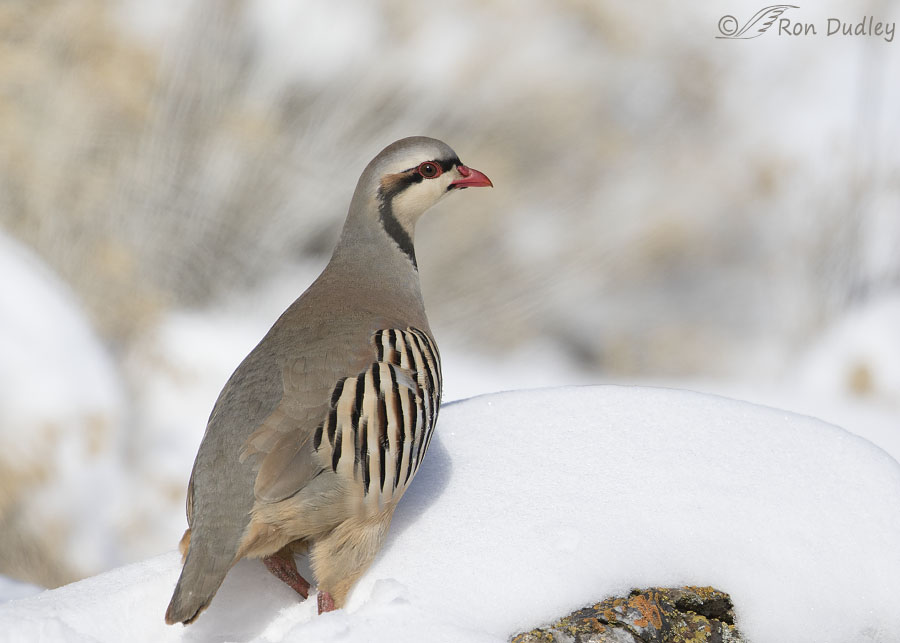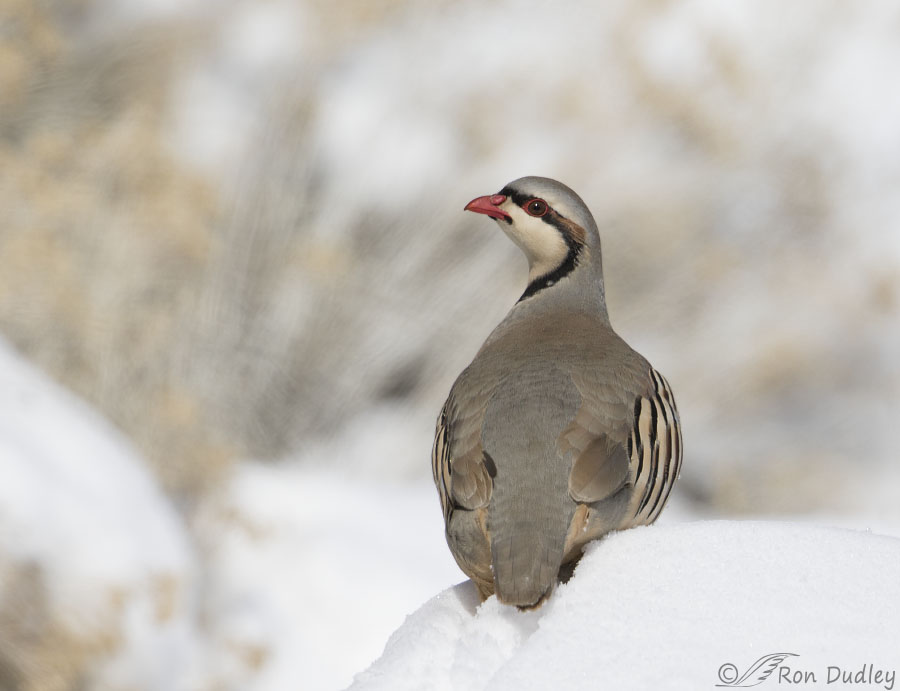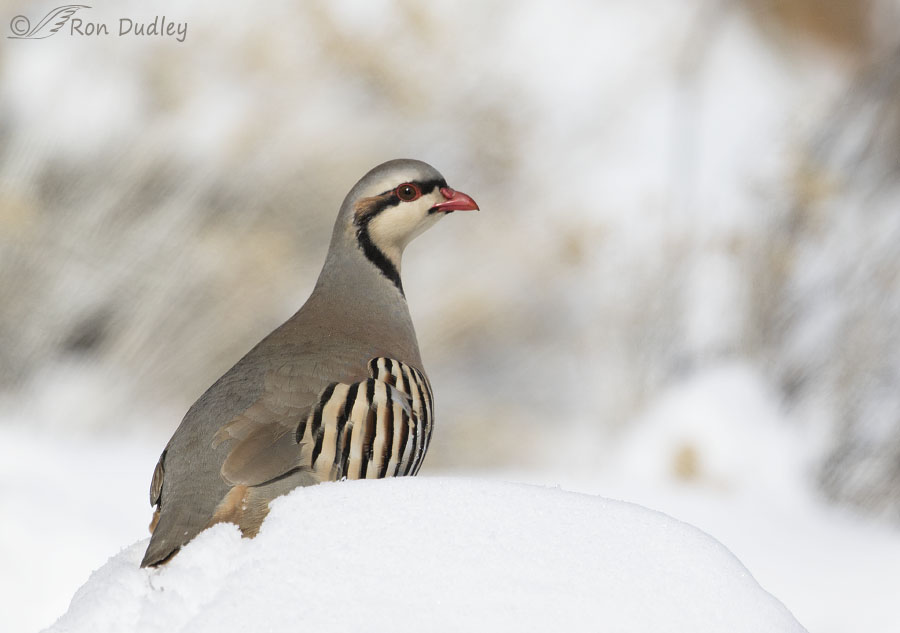Photographing this Chukar gave me a sense of accomplishment that I seldom get when I photograph them on Antelope Island.
On the island Chukars are relatively acclimatized to people and vehicles and hunting them is not allowed. As a result they’re abundant and often quite approachable. Nearly all of my Chukar photographs were taken on the island because anywhere else they’re extremely skittish and difficult to find. Their preferred habitat of steep rocky slopes dominated by sagebrush and cheat grass combined with their skulky ways make them a maddeningly difficult subject for photographers.
The experience is a similar one for those who hunt Chukars. They’re notoriously difficult to hunt because doing so requires exhausting treks into steep, unforgiving country in search of a sparsely populated and elusive quarry. Most Chukar hunters are completely worn out and frustrated by the end of the day. The following classic description of the Chukar hunt always makes me smile:
- “The first time for sport, the rest for revenge.”

1/2500, f/6.3, ISO 250, Canon 7D Mark II, Canon EF 500mm f/4L IS II USM + EF 1.4 III Extender, not baited, set up or called in
So I was delighted to get some reasonably good photos of this bird yesterday morning in a relatively remote area of the Promontory Peninsula in northern Utah. It was quite nervous and I could tell it was trying to decide whether to fly off or just walk away from me and disappear over the snow covered rock. In the end it chose the latter. This is the only decent shot I got before it crested the mound of snow and sadly I cut off the “virtual feet” of the bird.

1/2500, f/6.3, ISO 250, Canon 7D Mark II, Canon EF 500mm f/4L IS II USM + EF 1.4 III Extender, not baited, set up or called in
As it crested the “hill” it gave me an over the shoulder look and then…

1/3200, f/6.3, ISO 250, Canon 7D Mark II, Canon EF 500mm f/4L IS II USM + EF 1.4 III Extender, not baited, set up or called in
mostly disappeared over the mound of snow. After this all I could see of the bird was its head and neck sticking up so I started to drive down the road. As soon as my pickup began to move it flushed another Chukar that I hadn’t seen about 20′ away. Damn, I wish I’d seen that bird!
Yes, I probably have “better” Chukar photos then these. But my appreciation of these images illustrates one of my philosophies related to “degree of difficulty” when it comes to bird photography. Photos of truly wild Chukars are much more challenging to get than similar shots of the relatively tame birds on Antelope Island and in my book that puts a premium on them.
Viewers of my images don’t know the difference but I do.
Ron


Extra points for DOD!
I feel this way with shooting canada geese. Ones out in the wild, in NWRs acting like real geese are cool, but ones in town are trash birds like pigeons and starlings!
I haven’t seen a Chukar yet but will look next time I go to Antelope. Thanks!
Love your work, Ron, and my mom always forwards your posts to me. I’m an avid chukar hunter and blogger (chukarculture.com). A couple things I feel obliged to comment on about your post: first, speaking as a typical chukar hunter, while it might be frustrating to miss so many shots at these elusive birds, most of us feel tremendously satisfied after a hunt just because it’s a very fulfilling endeavor involving great exercise in gorgeous country where we rarely encounter other people (in my 17 seasons, I’ve yet to run into anyone else on “the hill”), and we usually work with amazing bird dogs whose instincts for finding, pointing, and retrieving upland birds is truly incredible. Second, the aphorism “First time for sport, the rest for revenge” isn’t something most chukar hunters really say or feel; in fact, most ethical hunters would never view their prey as something on which to exact revenge because they have too much respect for wild game. That might seem paradoxical to non-hunters, but it’s true. Finally, chukar are delicious if treated properly after the hunt; there is almost no fat on these birds, their breasts are white and their legs are dark, and I age them for 2-3 weeks before cleaning and freezing them (un-aged, they’re a bit tough). My blog has lots of recipes. Anyway, I hope you don’t mind my lengthy comment. And thanks for the great work you do!
I appreciate your “lengthy comment”, Bob. I actually know very little about Chukar hunting and have never hunted them so I appreciate you filling in some holes. My friend Jay Banta does hunt them though.
It was my assumption that “First time for sport, the rest for revenge” is said tongue in cheek and possibly out of respect for a worthy quarry. I can’t imagine hunting any bird out of revenge.
“…in my book that puts a premium on them.”
I’ll look forward to seeing the book. When might that be published?
Knew I shouldn’t have said that…
Such a beautiful bird. You almost want to hug and pet them. lol When a small child growing up, my Dad did go hunting for that bird, but not with a camera. I remember eating one. They tasted pretty good like fried chicken, only pretty greasy. Maybe it was not cooked right. Any way they are a fun round bird to watch and they pop up in the odd places.
Trudy, supposedly they’re one of the better-tasting upland game birds but I’ve never eaten one.
Awesome series Ron! beautiful work!
Thank you, Chantal.
Interesting. What is a chukar doing in Utah? They’re native to Eurasia, as I recall. .
Yes, they’re native to Eurasia but many western states have transplanted them for hunting purposes – similar to what’s been done with Ring-necked Pheasants. Our populations reproduce in the wild.
Beautiful images Ron! I love the background on them too. Are they widespread throughout Utah, or only around the shores of the Great Salt Lake?
Thanks, Ed. I wouldn’t say they’re widespread but our best populations of them are in the west desert “island mountain ranges”. There’s a lot of interesting and specific information regarding the question you ask (and others) in the following link if you’re interested:
https://wildlife.utah.gov/wildlife-news/1912-another-great-chukar-hunt.html
wonderful series Ron!
Charlotte
Thanks, Charlotte.
I have never seen one except on a farm .. beautiful bird beautiful picture especially in snow !!! ( my canon nightmares continue .. )
Thanks, Marina. I’m sorry to hear that…
Beautiful, and good to see the snow!
April, In general there was less snow up north than there is here but that’s pretty typical when you get away from the Wasatch Front.
It’s the “hunt” aspect of photography.
Yup…
Nice series…these colorful birds are particularly beautiful against pure, white snow….
Thanks, Patty. Welcome back and I hope you’re feeling better.
Man, this bird looks and acts perky, alert and as you said “wild”! Great shots!
To me there is a feel that emanates from your shots that this bird is truly wild and concerned about you in your truck. But, it seems he can accept your truck.
Dick, this bird was right on the verge of accepting me, or not. In the end it was somewhere in between. It didn’t fly off but it slowly skulked away.
Ron, I have quickly become an addict to your photography and share your enthusiasm, philosophies and also shoot with a 7D Mark II. Your images inspire me to get more from the shots I take and to strive for perfection. You never mention use of a monopod or tripod and I wonder if you are able to get so sharp simply handholding your camera? Please enlighten me as I struggle at times with sharpness.
Thank you for the kind words, Axekickr. I’m nearly always shooting from my pickup window, as I was with these shots. And believe me, we all “struggle at times with sharpness”…
The chukar is beautiful against the snow even if it has “invisible feet” Their colors stand out much better. Joe commented that “they ARE fast!” His mother raised some many years ago………
Their colors stand out much better. Joe commented that “they ARE fast!” His mother raised some many years ago………
Yes, they’re exceptionally fast runners, Judy. And their tendency is to sneak away on the ground rather than fly off.
As Rod Stewart put it, “every picture tells a story, don’t it?” Some stories (like this one) get told and some don’t, but the stories always enliven the pictures, one way or another.
Love the quote, Shoreacres. I’m a big fan of Stewart’s unique voice.